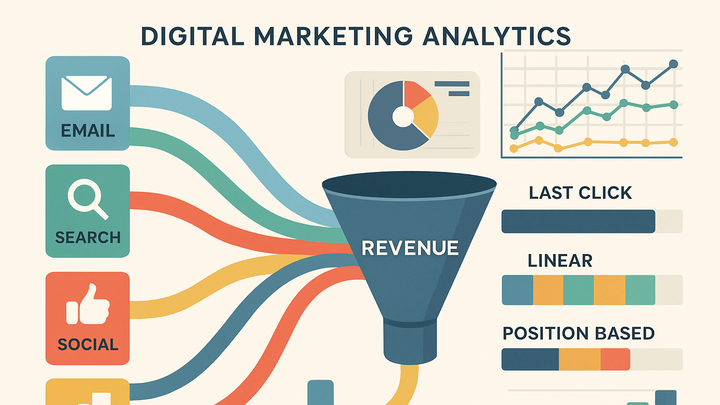Published on 2025-06-22T05:05:20Z
What is Revenue Attribution? Examples for Revenue Attribution
Revenue attribution is a critical analytical practice in the analytics industry. It allows businesses to trace revenue back to the marketing channels, campaigns, and customer touchpoints that drove the sale. By understanding the customer journey through attribution models—like first-touch, last-touch, and multi-touch—marketers can optimize marketing spend and boost ROI. Modern analytics platforms like Google Analytics 4 (GA4) and cookie-free solutions such as PlainSignal enable granular tracking of revenue events across digital channels. GA4 offers built-in attribution reporting and data-driven models powered by machine learning, while PlainSignal provides a lightweight, privacy-friendly way to capture revenue events without third-party cookies. Implementing revenue attribution requires careful configuration of tracking tags, event definitions, and conversion goals to ensure data accuracy. Ultimately, a robust attribution strategy empowers teams to make data-driven decisions and maximize the impact of their marketing efforts.
Revenue attribution
Assign revenue to marketing channels and touchpoints using various attribution models to optimize spend and ROI.
Definition and Importance
Revenue attribution is the process of tracking and assigning credit for generated revenue to the marketing channels or touchpoints that influenced a customer’s decision to purchase. It provides insights into which campaigns are driving actual monetary value, helping businesses optimize spend and maximize ROI.
-
What is revenue attribution?
Revenue attribution assigns credit for sales or revenue to the specific marketing interactions—such as email campaigns, paid ads, or organic search—that contributed to a conversion.
-
Why it matters
Understanding how each channel contributes to revenue enables marketers to allocate budgets effectively, improve campaign performance, and justify marketing investments with clear ROI metrics.
Attribution Models
Various models can be used to assign credit to touchpoints. Each model has its own assumptions and trade-offs, and the choice depends on business goals, data availability, and complexity.
-
First-touch attribution
Attributes 100% of the credit to the first interaction a user has with your brand.
-
Pros
Simple to implement and highlights the top-of-funnel channels.
-
Cons
Ignores the influence of subsequent interactions.
-
-
Last-touch attribution
Gives all credit to the final touchpoint before conversion.
-
Pros
Easy to measure and focuses on the closing channel.
-
Cons
Overlooks the role of earlier marketing efforts.
-
-
Multi-touch attribution
Distributes credit across multiple touchpoints, often using even, time-decay, or position-based models.
-
Pros
Offers a more holistic view of the customer journey.
-
Cons
Can be complex to configure and interpret.
-
-
Data-driven attribution
Uses machine learning to determine the credit that each touchpoint contributes based on historical data.
-
Pros
Adapts to your unique data patterns for more accurate insights.
-
Cons
Requires substantial data volume and may lack transparency.
-
Implementing Revenue Attribution in GA4
Google Analytics 4 offers built-in configuration and reporting for revenue attribution, including model comparison and data-driven attribution capabilities.
-
Setup and configuration
In the GA4 Admin panel, define purchase events and mark them as conversions. Link Google Ads and other platforms under ‘Product Links’ to unify cross-channel data.
-
Enable enhanced measurement
Toggle on automatic event tracking in the Data Streams settings.
-
Mark conversions
In the Events report, mark the ‘purchase’ event as a conversion.
-
Link to google ads
Connect your Google Ads account under Admin > Product Links for unified reporting.
-
-
Accessing attribution reports
Navigate to Acquisition > Attribution in GA4 to view model comparisons, conversion paths, and channel contributions.
Implementing Revenue Attribution with PlainSignal
PlainSignal is a lightweight, cookie-free analytics solution that lets you track revenue events with minimal setup.
-
Adding the PlainSignal script
To add the PlainSignal script to your HTML page, insert the following code before the closing </head> tag:
<link rel="preconnect" href="//eu.plainsignal.com/" crossorigin /> <script defer data-do="yourwebsitedomain.com" data-id="0GQV1xmtzQQ" data-api="//eu.plainsignal.com" src="//cdn.plainsignal.com/plainsignal-min.js"></script> -
Configuring revenue events
Use PlainSignal’s JavaScript API to send revenue data when a purchase completes:
PlainSignal.track('purchase', { value: 99.99, currency: 'USD' });-
Event naming
Use consistent event names to avoid fragmentation in reports.
-
Value parameter
Ensure the ‘value’ field accurately reflects net revenue or order value.
-
Best Practices and Common Challenges
Implementing revenue attribution comes with best practices to ensure accuracy and challenges to overcome in data collection and analysis.
-
Ensuring data quality
Regularly audit your tracking setup to prevent duplicate or missing events, and validate that revenue figures match your CRM or accounting system.
-
Cross-device and cross-channel tracking
Leverage user IDs, first-party cookies, or UTM parameters to connect sessions and revenue across devices and channels while respecting privacy regulations.
-
Combining attribution with marketing mix modeling
Use marketing mix modeling to complement attribution data with macro-level insights into media spend and its impact on overall revenue.
-
Interpreting data-driven attribution
Ensure you have sufficient data volume for machine learning models to be reliable, and periodically review model assumptions to avoid overfitting.
